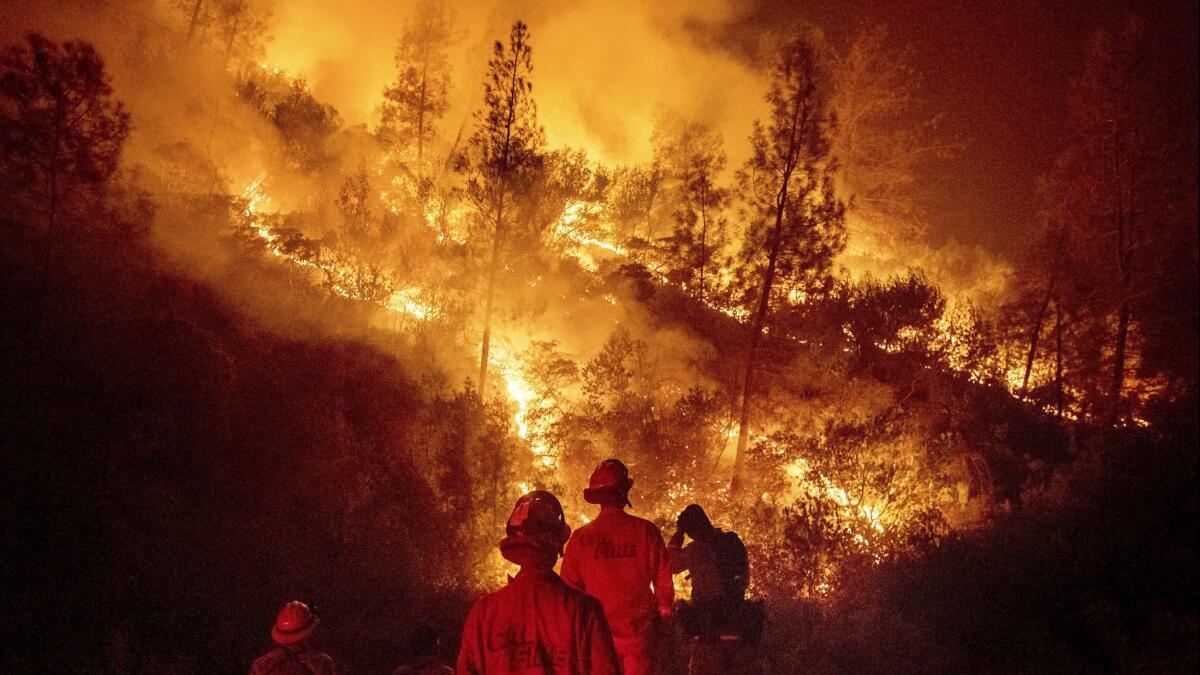Editorial: Climate change is going to make wildfires worse. Cutting trees and controlled burns can help

- Share via
Californians are already facing long fire seasons and record-setting blazes that have scorched the landscape and created clouds of soot. But this is just a hint of what’s to come as the planet gets hotter.
The state released its fourth Climate Assessment late last month, making a research-based projection for how climate change is likely to alter the environment and what the state can do now to help avoid the worst impacts. The picture is dire and the challenges are great: more severe heat waves, more floods, more beaches subsumed by the ocean, and even more frequent and severe wildfires.
Large fires of at least 25,000 acres will occur 50% more often by the end of the century if greenhouse gas emissions continue to increase, according to the assessment’s modeling. While many of California’s largest fires have burned in chaparral and foothill communities, more fires in the coming decades are expected to burn through the forests of the Sierra Nevada as warmer temperatures suck moisture from higher elevations. The average acreage burned every year could double or even quadruple under the most extreme warming projections.
Fire is not necessarily bad for forests. California used to burn with regularity, and low-intensity fires are vital in some ecosystems to clear excess brush and small trees from the landscape. But there’s been a change in fire behavior over the last century, as the state and federal government began dousing the blazes. Decades of fire suppression have allowed forests to grow dense with trees. Combined with drought, insect infestations and the stress of a warming climate, those management practices have led to more intense and destructive fires that are more dangerous to people living near the forests and more damaging to air quality.
As fires become more prevalent and intense, forests can become a net contributor to greenhouse gas emissions.
That’s not all the danger, however. Healthy forests are among nature’s most powerful carbon sinks. That is, they absorb and store carbon that would otherwise contribute to global warming. But as fires become more prevalent and intense, forests can become a net contributor to greenhouse gas emissions. The U.S. Forest Service estimated that the Rim Fire near Yosemite in 2013 emitted as much greenhouse gas as more than 2 million cars driven over a year.
California can reduce the risk of catastrophic fires and lessen the climate impacts when fires inevitably occur, but that requires spending a lot of money and time on forest management and fuel reduction. That means using controlled burns and cutting some trees to reduce forest density, both of which have been controversial practices.
Controlled burns generate smoke that temporarily worsens air quality, and they can turn into out-of-control fires. And cutting trees helps only if you cut the right ones. There is a real concern that, in the name of fire prevention, the Trump administration will relax environmental laws to allow more commercial logging in the national forests. Commercial loggers typically want the larger, healthier trees that are more fire resistant; they can’t make a profit cutting the younger trees and brush that are the biggest wildfire risk.
Enter the Fray: First takes on the news of the minute from L.A. Times Opinion »
California lawmakers sought the middle ground in the sweeping wildfire legislation package unveiled Tuesday, making an important and reasonable step toward reducing wildfire risk. The plan provides $1 billion over five years to do the expensive work of thinning the forests, cutting brush and setting controlled burns. The funding comes from the state’s cap-and-trade program, which collects fees from polluters for their greenhouse gas emissions.
The legislative plan also eases rules for cutting trees on private property. The exemption would allow owners of non-industrial timber land to cut some larger trees with commercial value without getting a state timber harvest permit, which can require hiring a professional forester to prepare and spending thousands of dollars. The change is designed to give private property owners more incentive to do preventive work and reduce the fire risk on their land.
It’s also a recognition that California has 15 million acres of forests in need of some kind of restoration. Even with $1 billion in new funding, the public sector can’t cover the cost of all the work that is needed — the private sector has to step up. The challenge will be ensuring that environmental and public safety interests, not commercial interests, drive the state’s policies on forest management. Regardless, the era of benign neglect of the state’s forests has to come to an end.
Follow the Opinion section on Twitter @latimesopinion and Facebook
More to Read
A cure for the common opinion
Get thought-provoking perspectives with our weekly newsletter.
You may occasionally receive promotional content from the Los Angeles Times.









